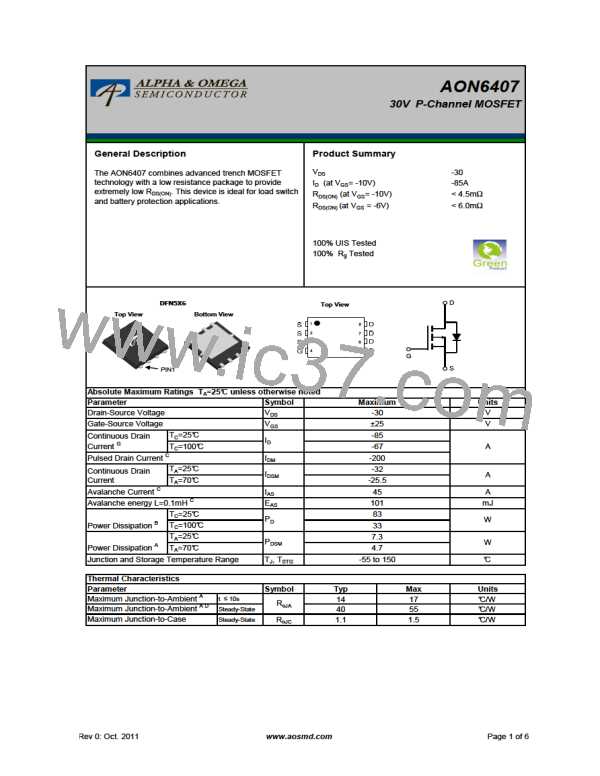AON6407
Electrical Characteristics (TJ=25°C unless otherwise noted)
Symbol
Parameter
Conditions
Min
Typ
Max Units
STATIC PARAMETERS
ID=-250µA, VGS=0V
BVDSS
Drain-Source Breakdown Voltage
-30
V
VDS=-30V, VGS=0V
-1
µA
-5
IDSS
Zero Gate Voltage Drain Current
TJ=55°C
VDS=0V, VGS=±25V
VDS=VGS, ID=-250µA
VGS=-10V, VDS=-5V
VGS=-10V, ID=-20A
IGSS
Gate-Body leakage current
Gate Threshold Voltage
On state drain current
±100
-2.6
nA
V
VGS(th)
ID(ON)
-1.6
-2.1
-200
A
3.3
4.9
4.5
6.5
6
mΩ
RDS(ON)
Static Drain-Source On-Resistance
TJ=125°C
VGS=-6V, ID=-20A
4.4
mΩ
S
VDS=-5V, ID=-20A
gFS
VSD
IS
Forward Transconductance
Diode Forward Voltage
65
IS=-1A,VGS=0V
Maximum Body-Diode Continuous Current G
-0.69
-1
V
-85
A
DYNAMIC PARAMETERS
Ciss
Coss
Crss
Rg
Input Capacitance
3505
900
650
4.6
pF
pF
pF
Ω
Output Capacitance
Reverse Transfer Capacitance
Gate resistance
V
V
GS=0V, VDS=-15V, f=1MHz
GS=0V, VDS=0V, f=1MHz
GS=-10V, VDS=-15V, ID=-20A
GS=-10V, VDS=-15V,
9.2
SWITCHING PARAMETERS
Qg(10V) Total Gate Charge
75
13
23
14
16
94
75
35
75
105
nC
nC
nC
ns
ns
ns
ns
Qgs
Qgd
tD(on)
tr
Gate Source Charge
Gate Drain Charge
Turn-On DelayTime
Turn-On Rise Time
Turn-Off DelayTime
Turn-Off Fall Time
V
V
RL=0.75Ω, RGEN=3Ω
tD(off)
tf
trr
IF=-20A, dI/dt=500A/µs
IF=-20A, dI/dt=500A/µs
Body Diode Reverse Recovery Time
Body Diode Reverse Recovery Charge
ns
Qrr
nC
A. The value of RθJA is measured with the device mounted on 1in2 FR-4 board with 2oz. Copper, in a still air environment with TA =25°C. The
Power dissipation PDSM is based on R θJA and the maximum allowed junction temperature of 150°C. The value in any given application depends
on the user's specific board design, and the maximum temperature of 150°C may be used if the PCB allows it.
B. The power dissipation PD is based on TJ(MAX)=150°C, using junction-to-case thermal resistance, and is more useful in setting the upper
dissipation limit for cases where additional heatsinking is used.
C. Repetitive rating, pulse width limited by junction temperature TJ(MAX)=150°C. Ratings are based on low frequency and duty cycles to keep
initial TJ =25°C.Maximum UIS current limited by test equipment.
D. The RθJA is the sum of the thermal impedance from junction to case RθJC and case to ambient.
E. The static characteristics in Figures 1 to 6 are obtained using <300µs pulses, duty cycle 0.5% max.
F. These curves are based on the junction-to-case thermal impedance which is measured with the device mounted to a large heatsink, assuming
a maximum junction temperature of TJ(MAX)=150°C. The SOA curve provides a single pulse rating.
IAS
G. The maximum current rating is package limited.
EAS
H. These tests are performed with the device mounted on 1 in2 FR-4 board with 2oz. Copper, in a still air environment with TA=25°C.
THIS PRODUCT HAS BEEN DESIGNED AND QUALIFIED FOR THE CONSUMER MARKET. APPLICATIONS OR USES AS CRITICAL
COMPONENTS IN LIFE SUPPORT DEVICES OR SYSTEMS ARE NOT AUTHORIZED. AOS DOES NOT ASSUME ANY LIABILITY ARISING
OUT OF SUCH APPLICATIONS OR USES OF ITS PRODUCTS. AOS RESERVES THE RIGHT TO IMPROVE PRODUCT DESIGN,
FUNCTIONS AND RELIABILITY WITHOUT NOTICE.
Rev 0: Oct. 2011
www.aosmd.com
Page 2 of 6

 AOS [ ALPHA & OMEGA SEMICONDUCTORS ]
AOS [ ALPHA & OMEGA SEMICONDUCTORS ]